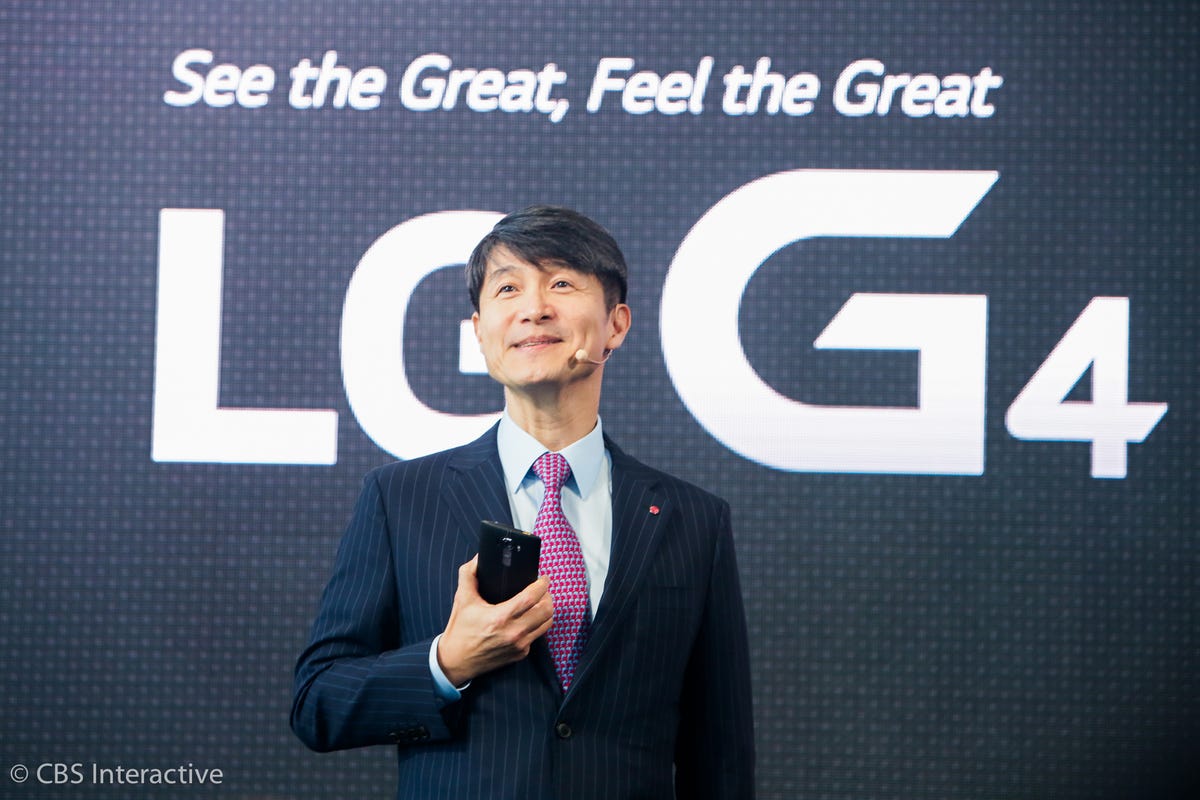
Sarah Tew/CNET
LG has some modestly optimistic expectations for its newest flagship smartphone.
The company expects to sell 8 million G4 smartphones this year and 12 million over its life cycle, according to Juno Cho, president and CEO of LG’s mobile communications business. That would represent a 20 percent improvement over the G3, which sold roughly 10 million units.
And it would still be a far cry from the heights reached by Apple, which on Monday reported selling more than 61 million iPhones in the first quarter of the year alone, or Samsung, estimated to have shipped 82 million smartphones in the first quarter. But the projection looks ahead to steady improvement for LG, which is still angling for a higher profile in the smartphone business. The Korean electronics conglomerate, best known for making televisions and appliances like washing machines, wants a bigger slice of the mobile pie, and is hanging on as the world’s fifth-largest smartphone maker.
Read: With leather-clad G4, LG fashions a rival to Apple and Samsung
LG clearly wants to make the G4 a big deal, as evidenced by its six-city global launch, including an unveiling Tuesday at the main event in Manhattan atop the One World Trade Center tower. Cho said in an interview he plans to spend 50 percent to 60 percent more on marketing to promote the G4. That’s a hefty improvement for LG, whose available cash of $2 billion is well short of Samsung’s $16 billion war chest or Apple’s vast cash hoard of $195 billion.
But will the G4, which sports a slight arc on the display and introduces a leather back, be able to distinguish itself enough in consumers’ hearts and minds against the notably redesigned versions of the Apple iPhone 6 and Samsung Galaxy S6?
“We want to really stand out and stay away from the rest of the pack,” Cho said. Instead of embracing metal for the phone body, LG designers opted to go with subtle changes that made the grip more comfortable. “We are very unique and stand out as an alternative for consumers.”
LG G4: Better screen, better camera and leather (pictures)






+23 more
The flair of the G4’s design seems like a step in the right direction toward keeping LG competitive with the likes of Apple and Samsung. The company had spent years working on the use of genuine leather as a material, which is one of the standout features of the G4, alongside the improved camera and more color-accurate display.
“The G4 keeps LG in the conversation about high-end smartphones,” said Ramon Llamas, an analyst at IDC. “The overall design merits praise.”


LG
LG showed off six different colors for the leather backing, which may make procurement of specific versions a problem down the line. Cho said he doesn’t believe there will be a supply issue with the leather version of the G4.
LG also introduced versions of the G4 with plastic as well as the leather versions.
Eventually, LG may play with different material. Cho said metal is a consideration for the G5. But he wants to find a novel way to utilize the metal so he doesn’t follow his competitors.
It’s unclear what the pricing will be on the G4 — the wireless carriers have yet to reveal specific price tags. While it costs more to produce the leather version, Cho said the company is still working out the final pricing with carriers in different regions.
Chang Ma, senior vice president of marketing for LG’s US mobile business, hinted that the difference in price wouldn’t be dramatic.
“We are trying to make it accessible to consumers as much as possible,” Ma said.


Now playing:
Watch this:
Leather smartphone? LG G4 goes for a different luxury…
2:55
While LG still lacks the brand power of an Apple or a Samsung, Ma said the recognition of the company has grown with each subsequent flagship phone launch. The result is a “double impact” of stronger marketing combined with more intense consumer interest — a strategy Ma spoke about a year ago with the G3 launch.
LG plans to have a broad campaign touting the G4, but Ma said he is working on promotional programs that reach out to individuals. As an example, LG plans to seed 4,000 G4 units to fans ahead of the launch to get their feedback, as well as to build buzz within the smartphone community. He said he plans to look at more programs that allow LG to have one-on-one contact with consumers.
“What I want to see next is how LG messages it to users as well as the price,” Llamas said. “The problem, as with many other Android smartphones, is differentiating against a slew of other high-end Android phones that also merit consideration.”
Samsung has long been the powerhouse among smartphone makers that use Google’s Android operating system.
While the G4 is LG’s top smartphone today, the company has already hinted at another even more impressive device for later this year. Ramchan Woo, the vice president in charge of the G4 project, hinted that the future device may look dramatically different.
Cho was relatively mum.
“We’ll have a chance to talk about it later on,” he said.



